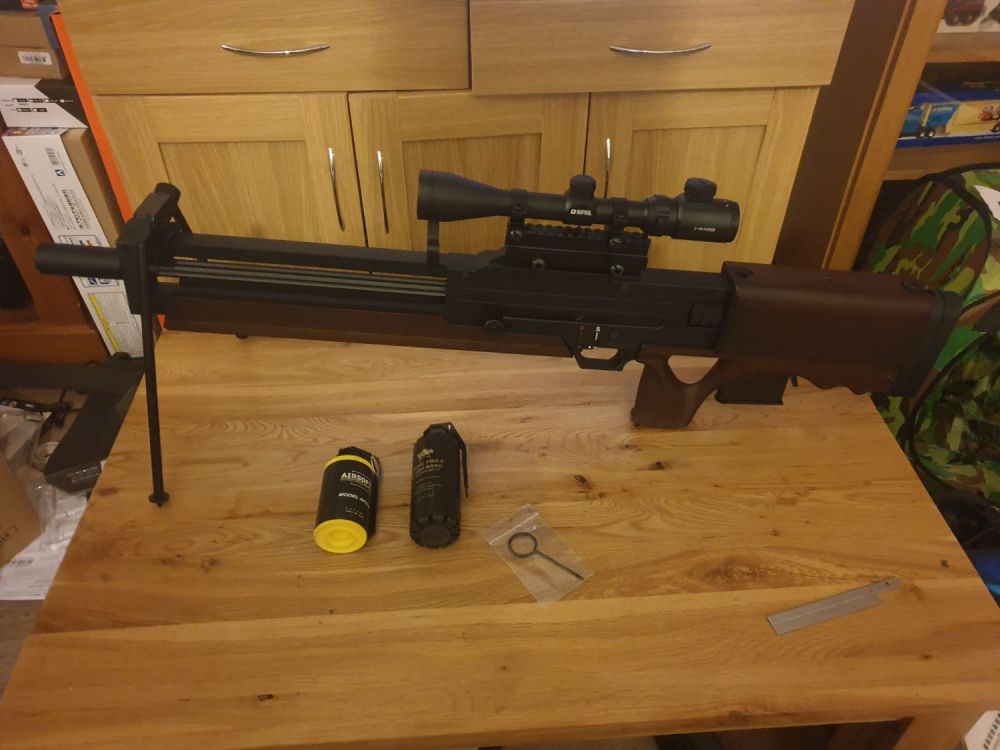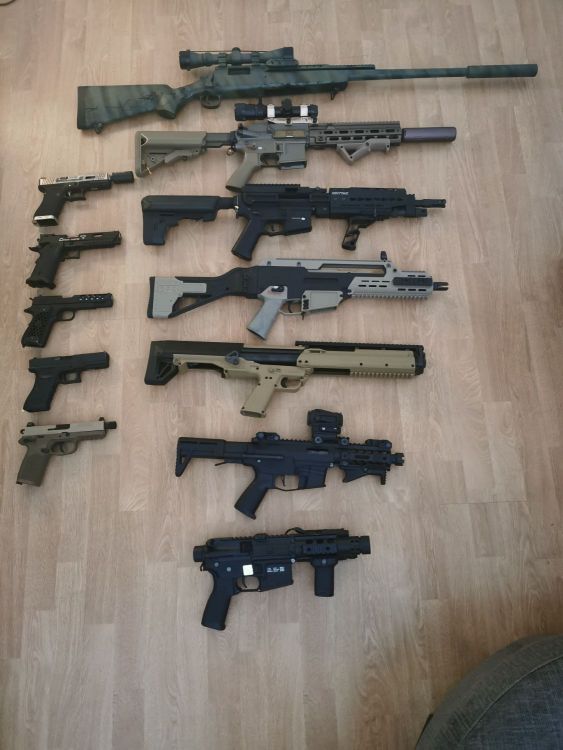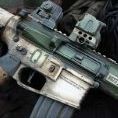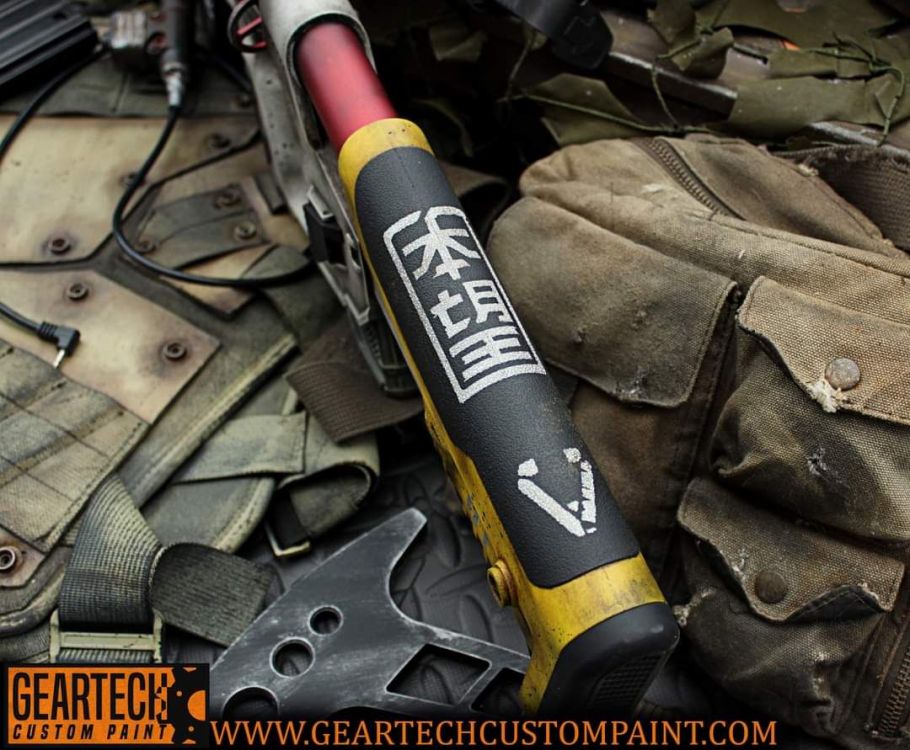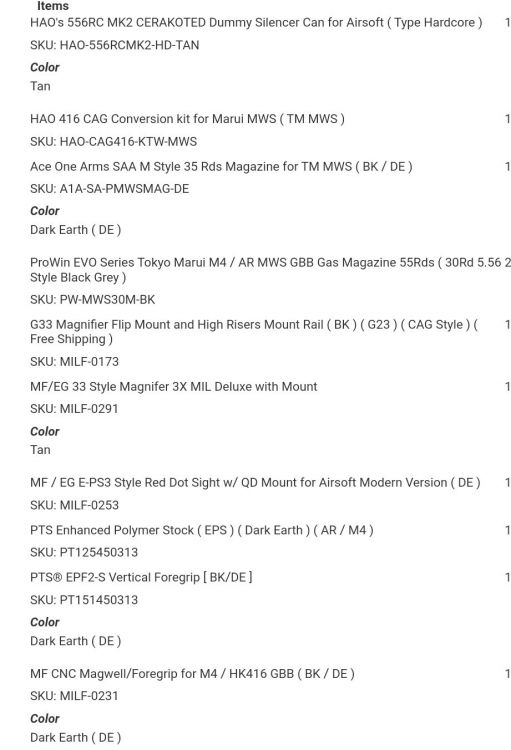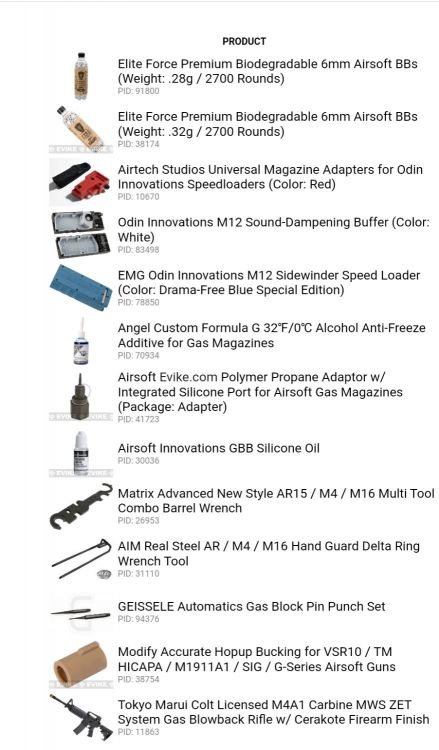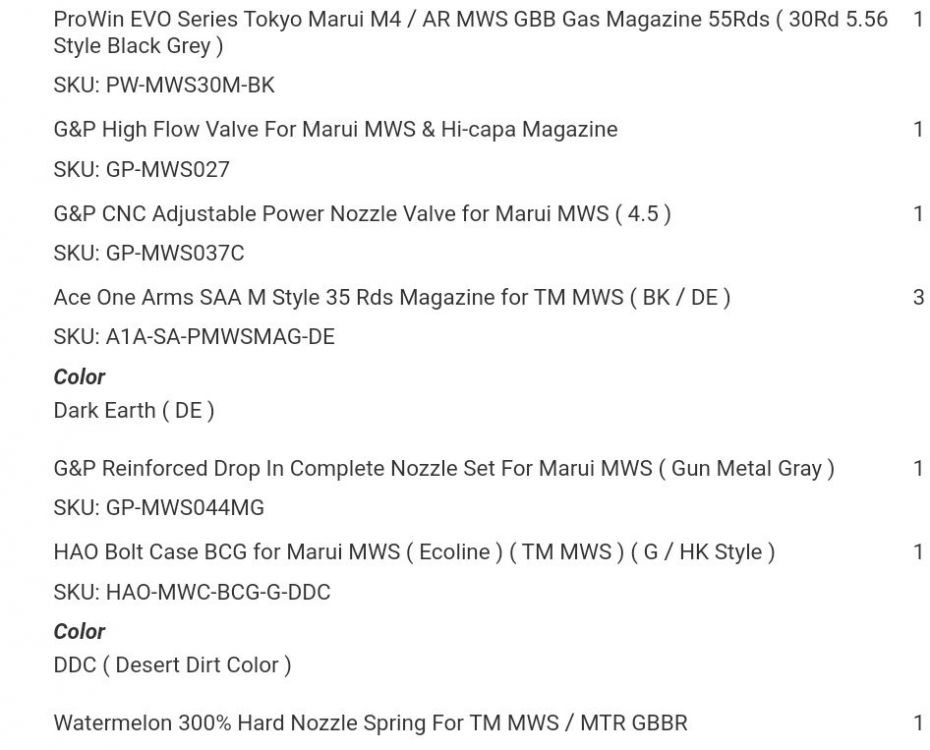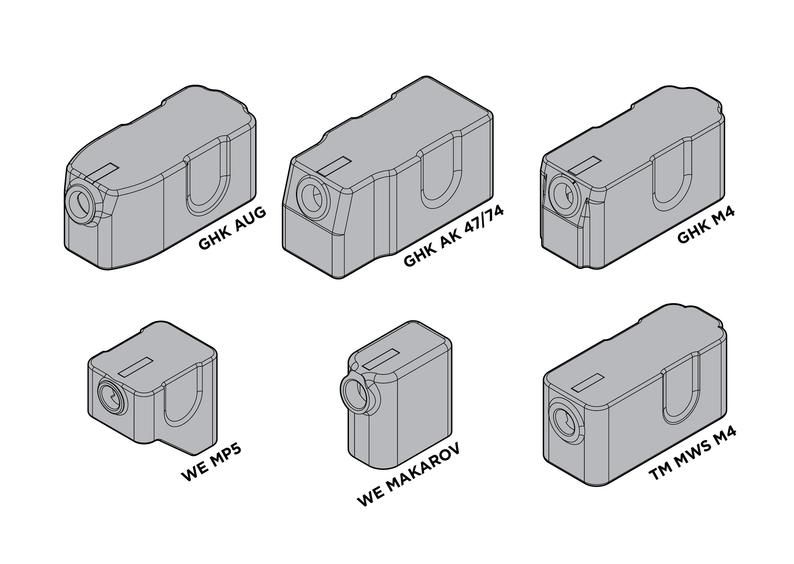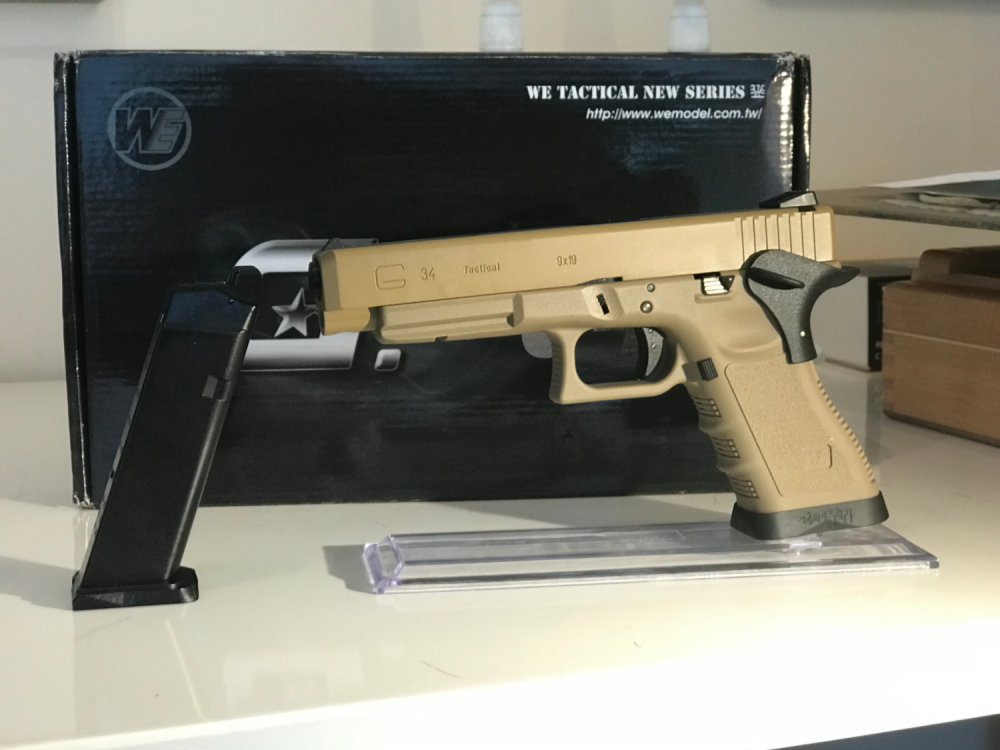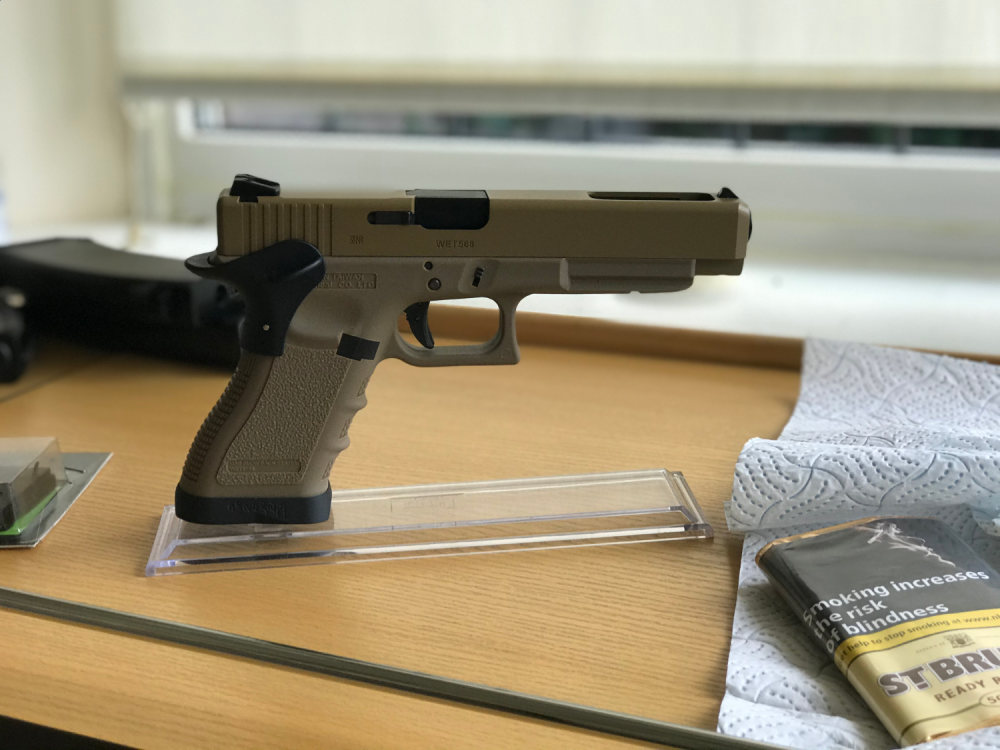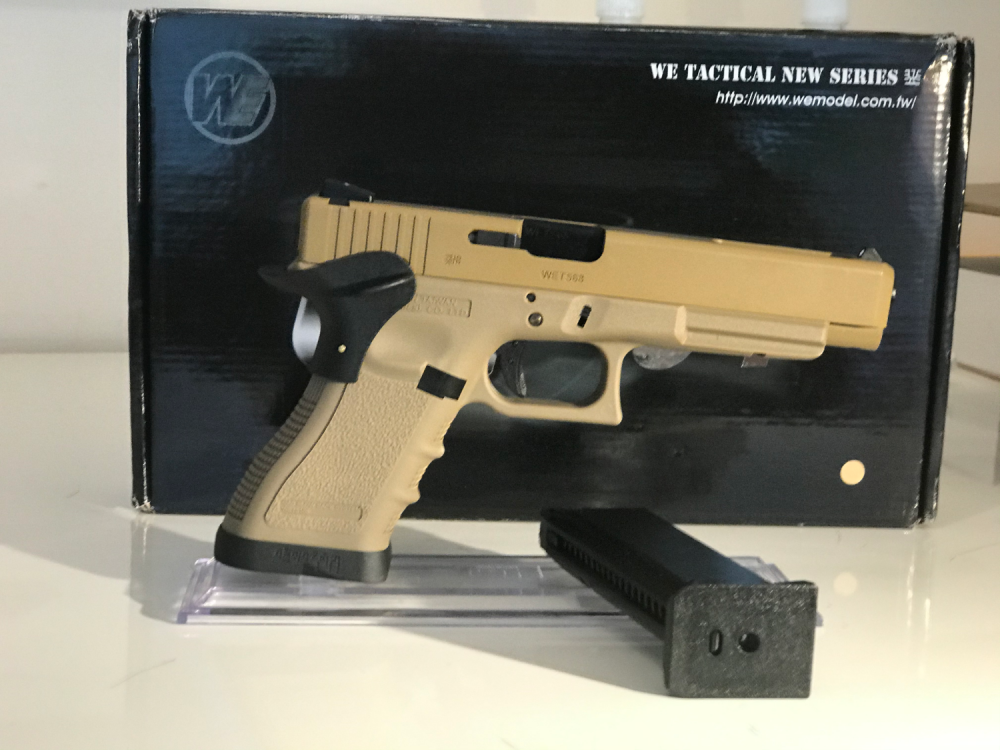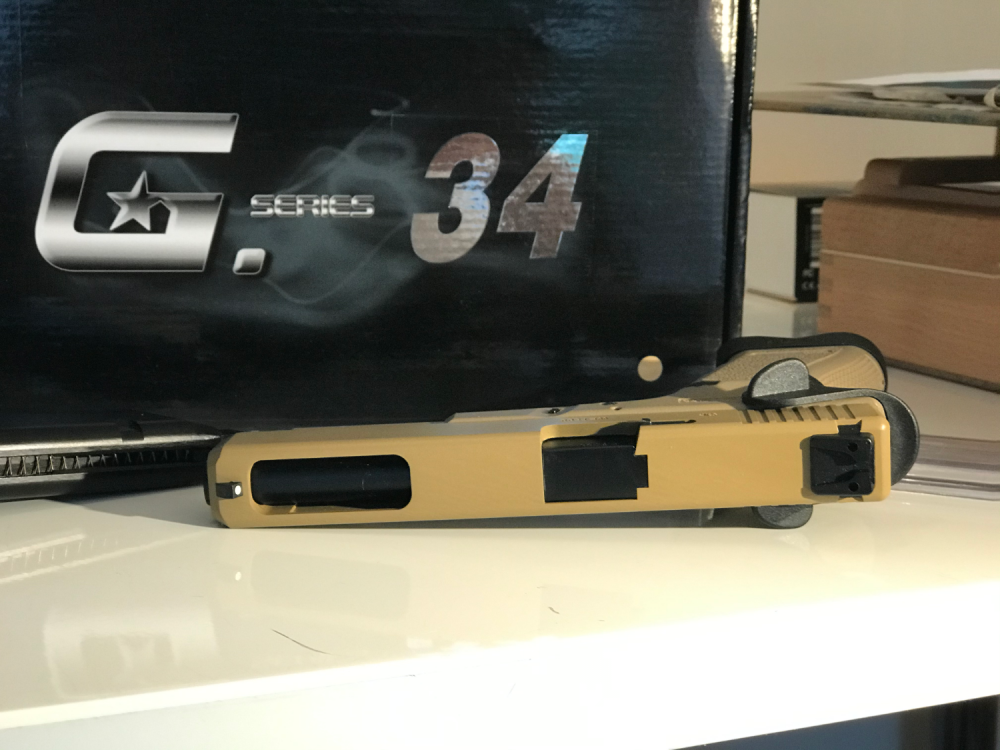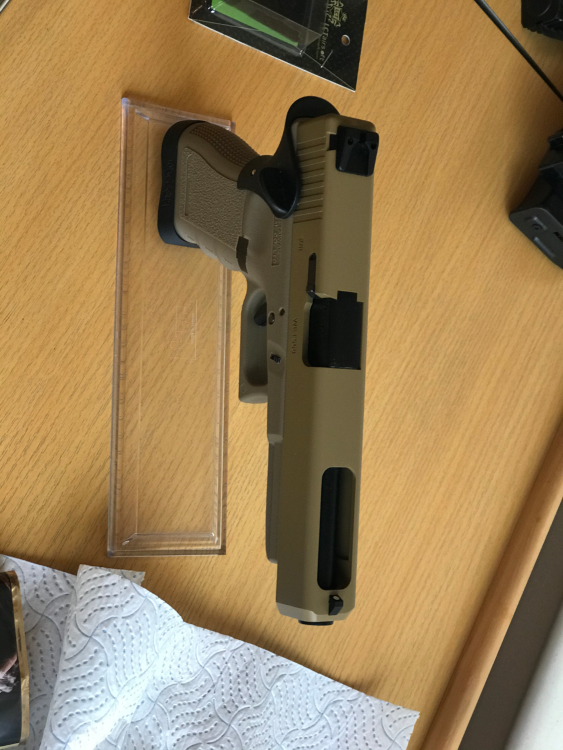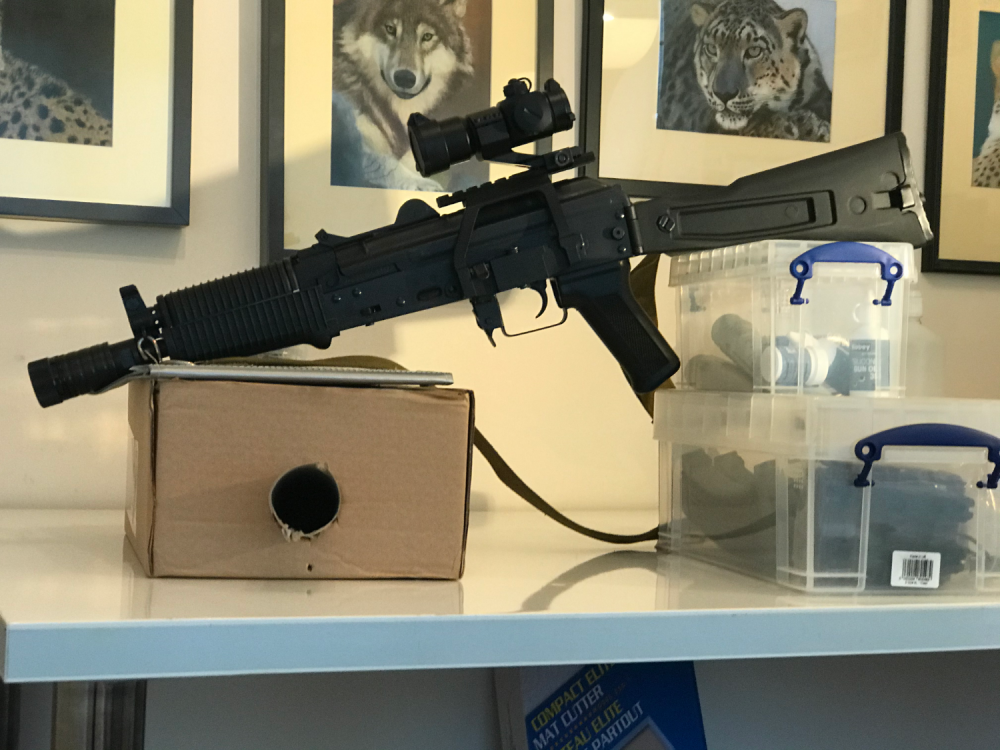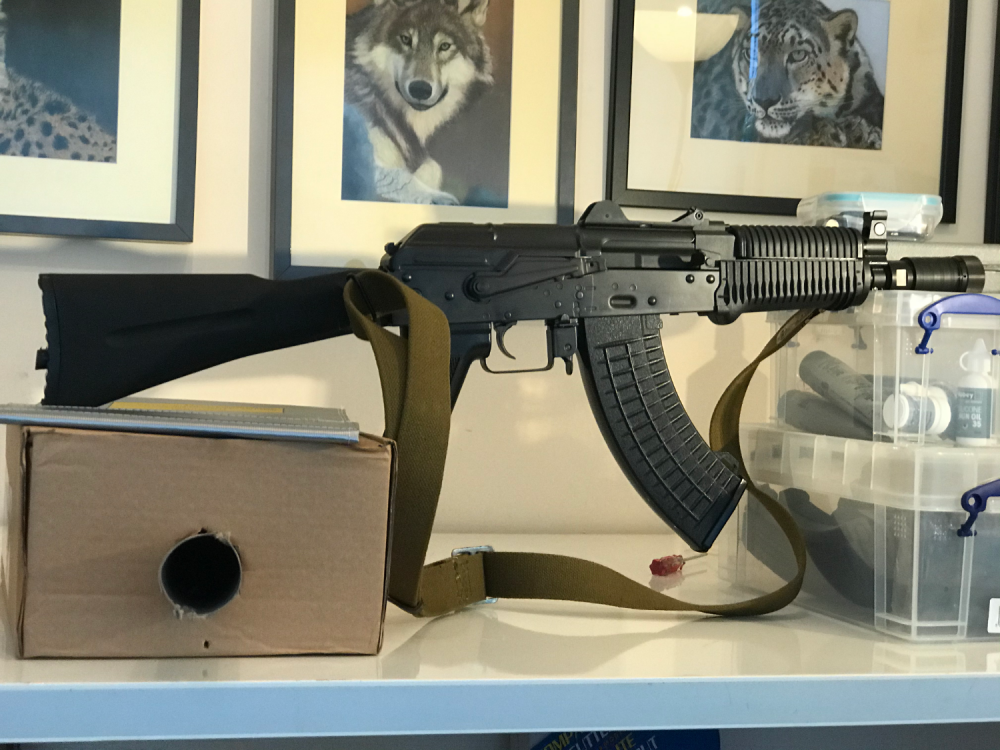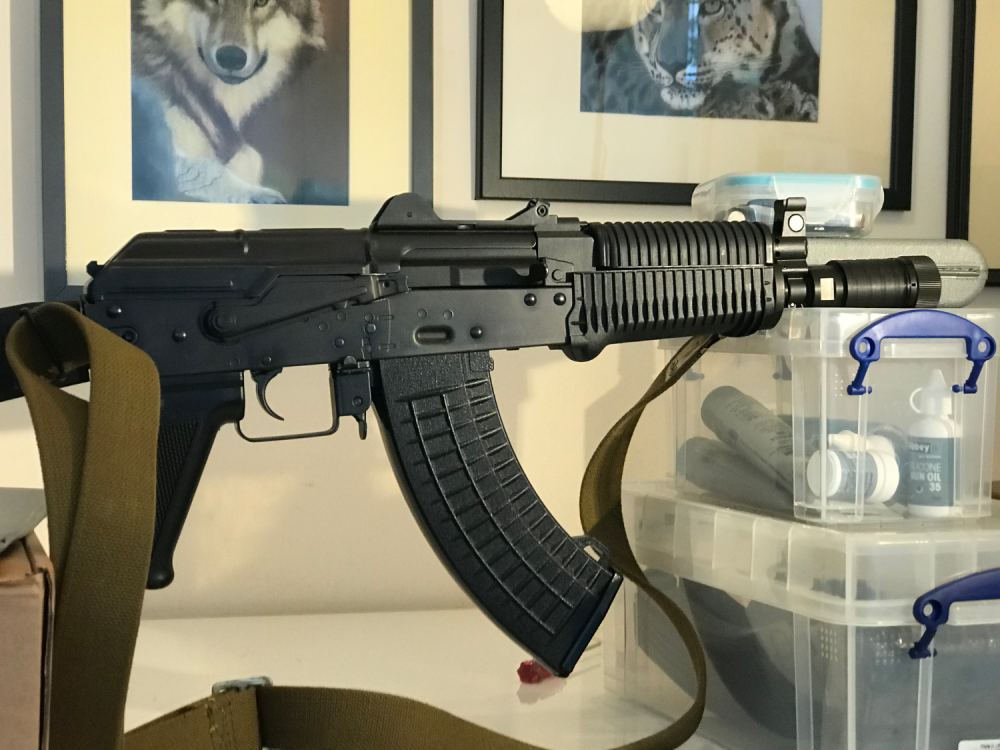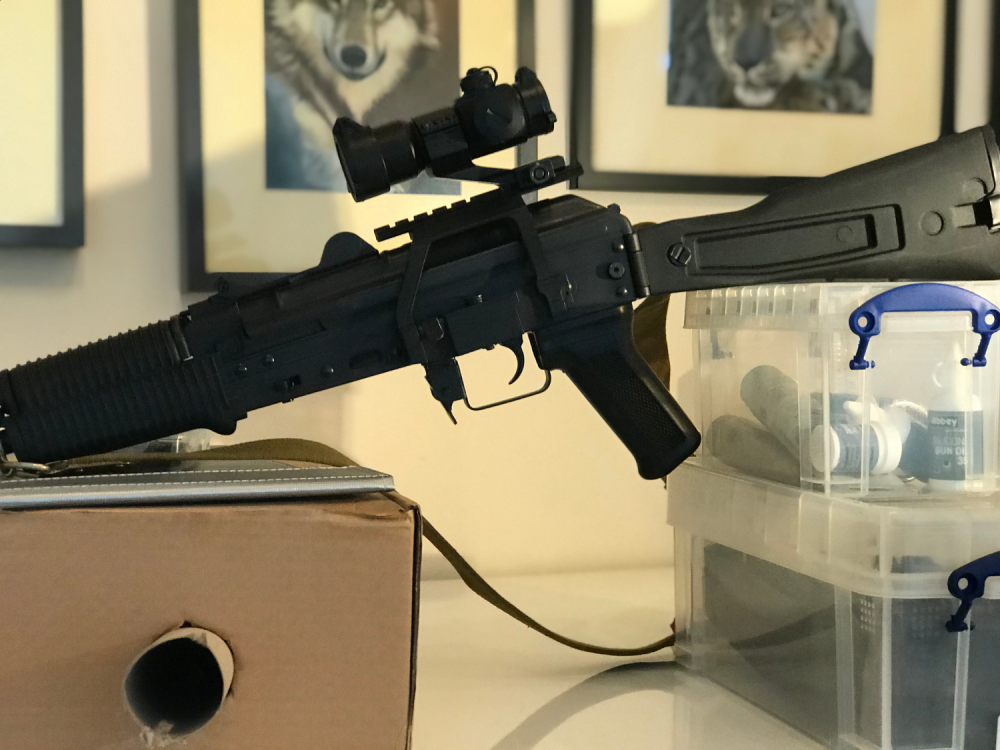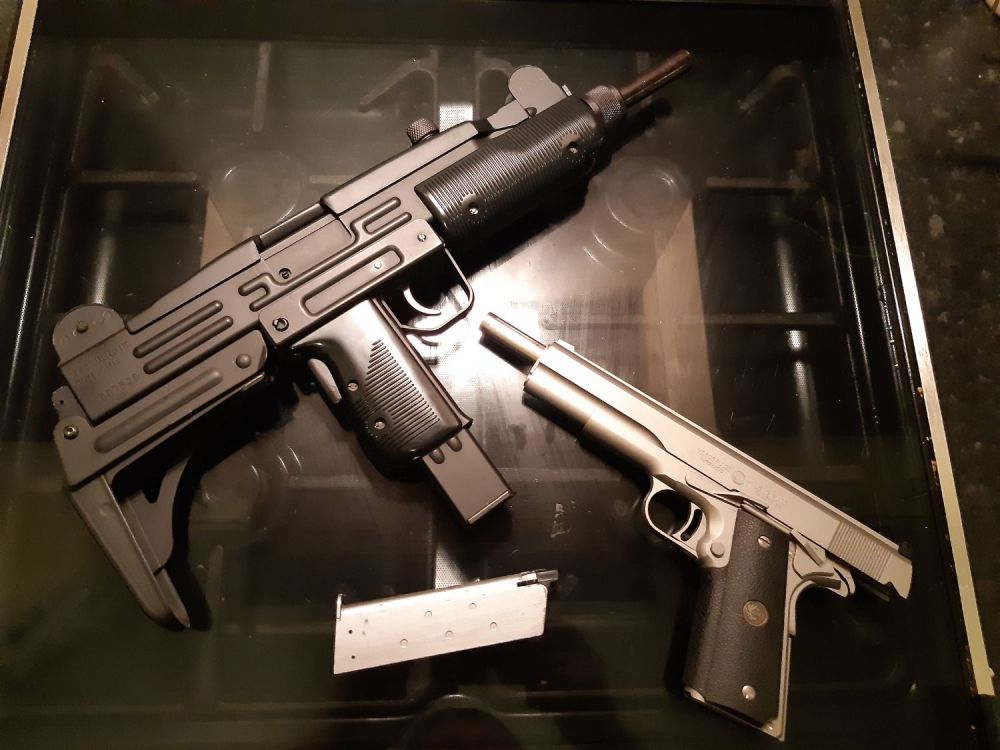Leaderboard
Popular Content
Showing content with the highest reputation on 26/09/20 in all areas
-
4 points
-

The 'What have you just bought' Thread
Pappa Large and one other reacted to Spartan09 for a topic
well, i have ended up spending WAY too much the last few weeks... i bought the tag rounds and shells that @DanRunham listed in the classifieds a couple of weeks ago ready for RIFT airsofts milsim event... but that has now been cancelled thanks to the latest from the government 😡 i also went to my airsoft supplier (combatuk / onlyairsoft in stevenage) to stock up on grenades and bbs... and i ended up buying a new gun.... ARES WA2000 plus nuprol scope... and scope riser to get proper sight picture2 points -
2 points
-
1 point
-

First Rebuild and Forgot to Buy Some Lub
Rogerborg reacted to Adolf Hamster for a topic
Its not their fault they have small feet.....1 point -

First Rebuild and Forgot to Buy Some Lub
Rogerborg reacted to TommoThomson for a topic
1 point -
When I wrote that notice, I had wrote it with the idea of a group having only six people within it. A game of 3 versus 3 (or 1 versus 5), shall we say. As with my earlier post in this thread, I agree with you that there is "fat chance" of two individual groups, bubbles or whatever not mixing yet playing the same game and adhering to the regulations in place, but I know that there are a couple of sites that are planning on using HSE/the Government's interpretation of mixing/mingling and treating it to a night it'll never forget.1 point
-

THE TM MWS thread
Wo1f reacted to Marroksteel for a topic
Going down the rabbit hole...... at least I'm in California and the weather is good year round. And if you can get etsy stuff shipped to the United kingdom this my be a nifty item. https://www.etsy.com/listing/855357705/speed-loader-adapters-compatible-with?ref=shop_home_active_1&variation0=15053097451 point -
It's a joke by the way. https://en.wikipedia.org/wiki/It's_Over_9000!1 point
-
First game with the MWS tomorrow. I confess I'm excited to be using my first ever GBBR. Will take 3 RIFS with me though as the days games are all different.1 point
-
I got the gas version because several reviews said the spring one is very hard to use and hurts the hand. This shop is in Spain and got it without a problem (with UKARA) https://www.airsoftestartit.com/en/airsoft-guns/gas-rifles/winchester-a-k-1892.html1 point
-
Been Out for 2 Years, What's New?
Seth_Erebor reacted to Musica for a topic
but his great great great granddaughter won't be.1 point -

Been Out for 2 Years, What's New?
Heath reacted to Cr0-Magnon for a topic
Not much has changed but we all live underwater.1 point -
i can belive it 15/16 years ago you couldn't give these away.1 point
-

Laser Conversion - Shock, Horror!
Shamal reacted to Adolf Hamster for a topic
for me? yes, i take great pleasure in what passes in airsoft for marksmanry, indeed i appreciate not only making a long range shot, but also being tagged by a long range shot. if i wanted to play point and click i'd stay home and play call of duty. don't get me wrong, there are aspects of this hobby i hate, and cheating sits right on the top of the pile. but frankly it's not like you're going to escape it with lasers, i'm sure given enough ingenuity someone's going to cover their sensors or some other shenanigans to make them proof of hits. sure laser tag might have a range advantage, but frankly not many airsoft sites are going to have the kind of ranges where you could utilise it anyway, and as much as we laugh as the ridiculousness of using leaves as cover at least a bb can have a crack at punching through whereas i doubt a laser is going to work quite so well. frankly these days i'm kind of coming to the conclusion that there are very few, if any, problems with airsoft as an enjoyable pastime that couldn't be solved by everyone involved being honest sportsmen.1 point -
This is the crux of the matter. Too many people in general are taking the "I'm alright Jack" approach without consideration for the wider effect they are having. It's not just about you, or your immediate household but all those people that you may come into contact with on a daily basis. You go to a group activity, someone has undiagnosed Covid and passes it to you. You don't have symptoms so you go about your life as you would, being careful but still "getting on as best you can". You go to the shops, you go to work, you go to the pub. Spreading it about for all to catch, all completely unaware that you are an asymptomatic carrier. Yes, it's a shit situation, yes it sucks that you can't do the things you want to but this is not a scenario we have had to deal with in our lifetime (not even in my Dad's lifetime and he's 94). It's time for society as a whole to realise that it's "us" not "I".1 point
-
been tempted by one since they were first released but yet to purchase one, do though like it a bit higher on the chest.....still i should go have another look!1 point
-
Don't remind me when I bought mine some 2 years ago M81 wasn't available yet Fucking Helikon really1 point
-
Gun picture thread
NeatBeard reacted to emilianoksa for a topic
1 point -
1 point
-

Gun picture thread
EDcase reacted to Cromulon1994 for a topic
1 point -
1 point
-
I had an enthusiastic chap tell me a WE M14 had similar recoil to the real thing. Guessing he'd never shot a .308 or any kind of firearm...1 point
-
How about the biggest fallacy of all times, told by the airsofter to himself or other people : " if i buy this replica/gear, i'll have all i need/want and will defo not need to buy anything else ".1 point
-
Mine was believing about a high cap mag once you wound the mag to get the BB’s at the business end you was all good .............1 point
-

Hamster's Guide to the Polarstar Product Line.
Encore reacted to Adolf Hamster for a topic
Well it’s lockdown and I’m bored, so might as well write a guide/review/thing about the black magic that goes into an HPA. Hpa in general is a dark art to some, so maybe it’s worth writing down some of my experiences to help folk understand hpa and the issues you can face. I’m going to focus primarily on polarstar’s product line because their products are the ones I’m most familiar with, but I’ll make a few mentions of other brands and what they offer with the caveat that my hands-on experience of running them is very much limited to second-hand information. This is probably aimed more at people looking to get into hpa and may find it useful knowing the benefits/limitations of certain systems. First things first lets clear up some misconceptions: Hpa is accurate- yes and no, like any airsoft gun just having an hpa kit doesn’t immediately turn it into a laser beam of death, your hop, barrel, ammo, tuning etc are all still very important factors in accuracy and a badly setup hpa can still fail to hit the broad side of a barn from inside said barn. However, with that said a good hpa kit can, in a good gun, offer superb consistency and accuracy, but you must work for it. Hpa’s run hot- yes and no, there’s a very strong stigma that hpa users always turn up their regulators then run around pinging everyone at 600fps the moment the whistle blows. Well whilst I’ll not deny that there’s a certain type of person who originated such a stereotype not everyone that has an hpa does this. A perfect example is a game about a year ago where literally every single player was running an hpa, and I’m not gonna lie even I saw all those air lines and made the same assumption. But I was wrong and it turned out to be a day filled with the most sportsmanlike conduct I’ve ever experienced playing airsoft, nobody was running hot, nobody ignored hits, nobody overshot (in fact i can’t remember using auto at all the entire day), and everyone had a fantastic time as a result. What I will say is that a cheater is a cheater no matter what he’s using, and it’s not like hpa is the only system that enables quick energy adjustment, hell the quick change spring on an evo or systema is every bit as amenable to that kind of thing. Hpa’s hose everyone with a million bb’s- again yes and no. I’d be a hypocrite if I said I’ve never tried running a high rof, and there are a few limited scenarios where it can be useful (most particularly punching through heavy undergrowth) but it shouldn’t take long to realise that it’s mostly just turning plastic into hatred from your fellow man. On a technical standpoint not all systems are capable of running stupid rates of fire anyway, and normally you’ll end up sacrificing actual accuracy to obtain accuracy by volume and frankly I’d much rather have the former because it’s cheaper. To me at least the true power of an hpa system is having accuracy and good trigger response so that you can make that first round hit and if they need more convincing quickly follow it up with a second (or however many it takes to convince them that the respawn flag is where they want to go) whilst an hpa can sustain 40+rps with minimal effort (certainly compared to extracting the same from an aeg) it doesn’t mean you can’t or shouldn’t run slower. Hpa’s are super loud/quiet- these are both true, in essence an electro-pneumatic hpa system is going to have minimal cycling noise compared to the whirring gears and slamming piston of an aeg, therefore the primary source of noise is from the “pop” of air when the bb leaves the barrel. Depending on the setup (eg a short barrel with high pressure will be louder than a long barrel with low pressure for the same fps) this can be made to sound very loud with an amplifier, or with a nice foam filled suppressor very quiet. Personally I find the ability to suppress these guns and make them effectively silent is a wonderful side benefit especially if you enjoy sneakier types of gameplay. So I’m going to do this in a vague order of pricing, at least in terms of the engines. I’ll cover the functionality and a few of the noteworthy issues, the basic tuning method, and recommendations for use. Polarstar jack/f1 left dissassembled jack showing internals, right F1, note the larger solenoid functionality The jack is polarstar’s cheapest system (at least until Kythera hits the shelves) and it’s wonderfully simple, it only has 1 moving component and has very simple setup. The f1 is more expensive with a bigger solenoid but functionally it’s pretty much identical. These are a “drop-in” system, essentially the engine quite literally drops in your standard aeg gearbox in place of the cylinder, you remove the gears and replace the trigger contacts with the included trigger module (more about the different trigger options later). The air line can then be routed generally out of the grip (as the motor housing has a convenient hole for it to go through) and the wiring for the fcu generally goes wherever you had the original aeg battery going (an fcu+mini battery takes up about as much space as a small 11.1v lipo). f2 installed in a v3 gearbox, note the trigger board replacing the original contacts. The way these work is the nozzle is a 1-piece unit that is held in the rear position constantly by air pressure around the outside of the nozzle. When you fire air is sent to the base of the nozzle pushing it forwards, when the nozzle gets almost all the way forwards (about 2mm from the end of travel) it uncovers a set of ports, these ports allow air from the chamber outside of the nozzle to pass through the nozzle and down the barrel. This makes it an “open bolt” system, as the nozzle always starts from the open position and during firing must travel forward, pick up a round, and fire. Very much in the vein of open bolt RS guns like the sten. limitations The main advantage is the extreme simplicity and accompanying low-cost. However it’s not a perfect system. The primary issue with this open bolt setup is the sensitivity to timing. Unlike even a standard aeg this system has a habit of sending air down the barrel before the nozzle is fully forward meaning in short it makes its own air leak. Now with a good hop rubber and having exactly the right nozzle length for the gun will definitely help improve things but there’s a limit even to that. The practical outcome of this is accuracy, or lack thereof, at best a jack can operate at the level of an good aeg in terms of shot-shot consistency but it’s very easy for incorrect setup to make it very poor indeed. The second issue is that of pressure, it affects pretty much all hpa systems in some way but the jack/f1 being a completely pressure driven system means it’s particularly noteworthy. In essence this limits how low-powered you can make the gun for a given barrel length. For example as standard I found that on a 275mm barrel I would be running ~75psi to get 1j on an 0.3g bb. The problem here is that things like pressure on the bb from the magazine means that it can struggle to feed, and in my particular case this would mean the first 20 or so rounds in a midcap would struggle to feed, yet the last 20 or so rounds would have no such issue. This of course will depend entirely on the particular setup of the gun, having a higher energy limit, shorter barrel or weaker magazine will reduce the impact of this. For example the inner barrel on my 42 is about a foot shorter than the original to allow it to run properly. It is possible to block some of the ports on the nozzle to make a pseudo “low-flow” which can help (by meaning you run a higher pressure for the same muzzle energy), but it won’t solve the inherent problems of accuracy. Tuning So tuning these systems is relatively simple and involves only 2 settings: dp and rf Dp is poppet dwell, in short it’s how long the system activates the solenoid for. In these systems this covers essentially the entire firing cycle. The best way to tune this is to set the dp to maximum, then on the bb weight you use set the pressure until you get your desired energy. then drop the dp value, chrono a few shots, drop dp again, and repeat until you see the energy drop. You want to set the dp value just above where the energy drop occurs. Of course any significant changes to bb weight, barrel length or energy are going to change how “optimal” this is and it may need re-set if you change any of these. Rf is rate of fire, and it does pretty much exactly what you think it does and limits the rate of fire. Now as far as I can tell this setting overrides the dp setting, so if you set the rate of fire faster than it takes for a completed shot then it’ll result in an energy drop (just like if your dp was set too low). Practically this means in full auto your rounds are going to drop given your hop unit and sights are likely set for where the bb is going in semi auto. If you take this to the absolute extreme the system won’t even cycle. now you need to consider why exactly you want a ridiculous rate of fire, I’m not going to say that I haven’t chased speed, or that there aren’t some specific scenarios where a stream of bb’s can be useful. However, think of the poor sod on the end of that stream of plastic. I’m all too aware that it doesn’t always take just 1 bb to get a hit call but that’s no excuse for sending 40 rounds at every person you see. Remember the most important rule of airsoft: don’t be a dick. conclusions The jack/f1 is a very simple setup, and as such pretty much the only thing available for it is different length nozzles for different guns. As I explained earlier it’s important to get one the right length for your gun. If you’re running a weird gun that they don’t do a nozzle for then pretty much your only option is going to be to get one longer than you need and turn it down on a lathe. Tbh I think in terms of usefulness I’d recommend considering leaving open bolt hpa systems for support guns or cqb guns where precision isn’t a massive priority. for the cost of a jack and hpa setup you can easily get an aeg to shoot just as well and pretty much the only things you’d gain with the jack are trigger response (even as an open bolt it’s almost instant) and reliability. Certainly if semi-auto accuracy is your priority I’d direct you to either the f2/fusion, or another manufacturer like wolverine, redline or mancraft. Polarstar f2 internal CAD view of the f2, note the seperate solenoids for controlling the main airflow and the nozzle movement. functionality The f2 is one of polarstar’s newer products and in my opinion offers the most flexible platform in terms of a universal drop-in system that can provide the tuning functionality to extract excellent performance. The f2 is a “closed bolt” system, this means the nozzle rests in the closed position under a spring. Of course this means it’s a fair bit more complicated internally than the jack/f1 and has a separate nozzle/poppet arrangement and a pair of independent solenoids. However the trade off for this is a massive increase in tunability and a system that is inherently easier to tune for accuracy. An f2 in the right gun can provide excellent fps consistency and therefore accuracy, especially for semi-auto. Limitations Unlike the jack the nozzle length isn’t as sensitive for accuracy, however it’s still as important as it would be in an aeg. Of course there are a range of nozzle length options for different guns including options for offset nozzles such as an m14 or f2000. Additionally, the system is slightly chunkier than the jack, and has a protrusion for the air inlet which can cause some fitment issues depending on what else is going on in the gearbox. You may need to get creative with a Dremel in some scenarios. The main issue is that of tuning, this is a blessing and a curse because whilst there are more settings that provide the flexibility to dial in the system precisely to the setup you’re using, it’s also easy to get unexpected behaviour. Like the jack and other hpa systems it is sensitive at low pressures. However unlike the jack there are some good options to solve it. Firstly as the nozzle is spring biased you really only need enough pressure to cycle the nozzle properly, higher pressures will make this easier of course. Whilst I mentioned blocking ports on the jack there’s a much better solution for the f2- a low flow poppet. In essence this does exactly the same thing (higher pressure gives the same energy) and for lower powered setups this is a very good drop-in to improve cycling. Tuning So the f2 has a much more complex tuning to that of the jack/f1, so for starters it’s good to know how the firing cycle works: 1. The poppet solenoid activates opening the poppet, this sends air (and the bb) down the barrel 2. The poppet solenoid closes air stops going down the barrel 3. The nozzle solenoid opens, the nozzle starts moving backwards, at the rear of travel a bb pops up from the mag. 4. The nozzle solenoid closes and the nozzle returns forwards under spring pressure, chambering the bb. The timing of each of these phases can be controlled separately, which is where the flexibility comes in: CB- the first setting to note is “closed bolt” operation, now this is a bit confusing because in reality the system always fires from a closed bolt, all this setting does is change which point in the firing order the system chooses to run. When running “open bolt” in semi-auto the system rests after point 2, with no round in the chamber. Upon firing the system operates 3,4,1,2. In closed bolt the system rests after point 4, so there’s a round sitting in the hop, upon firing the system operates 1,2,3,4 So why choose one or the other? Well in closed bolt mode when the chamber is empty and you fit a magazine the first round fired will be a dud, because there’s no bb in the chamber. Likewise, if you pull the mag it can still fire that 1 round that’s in the chamber. In practice it’s very easy to get into the habit of pulling the trigger once after reloading and firing a few shots after unloading to ensure the action is clear is good safety practice that should be exercised anyway. In theory there should be a slight improvement in trigger response running closed bolt too, although practically the system is so fast that it’s not really an issue. I prefer closed bolt as first round accuracy tends to be a bit better. If you run a hop-up tracer unit you may wish to run open bolt as this means a tracer round won’t be sat in the chamber losing its glow before the shot is fired. Dp- poppet dwell, unlike the jack/f1 this controls only the poppet solenoid and defines how long between steps 1 and 2 (the setting is literally a delay in milliseconds), or how much air the system sends down the barrel. To set this the method is pretty much the same as the jack- set to maximum, use your game ammo to set the pressure to give you the correct energy, then drop dp down to just above where the energy starts to drop. Again as before changes in energy, bb weight or barrel length are going to affect what the optimal setting for this is, for example I literally have the dp settings for 0.3g and 0.48g engraved in the stock of my m4 so I can set it correctly depending on which ammo I’m using. If you want to use an aeg based analogy the dp setting is the equivalent of your cylinder volume and allows you to adjust the equivalent of how far down the piston the vent hole is cut. Too much or too little will affect your accuracy so it’s a great feature to be able to tune this precisely even so far as to changing on the fly for different ammo. It’s also the dp setting that’s responsible for the phenomenon of joule creep, you may note that I make a point of stating to use your game ammo to set the poppet dwell and the reason being is that setting on heavier ammo will make the system over-volumed. Basically what happens is that when firing an 0.2g the lighter ammo accelerates and leaves the barrel quicker, meaning it can only pick up so much energy for a given pressure, heavier ammo will take longer to accelerate and so spends more time picking up energy. it’s a widely misunderstood phenomena and why it’s important to chrono on the ammo you’re using. I make a point of doing this and if the site chooses to chrono on lower weight ammo it doesn’t matter if the fps reading appears to be low on 0.2’s, what matters is that the ammo you’re using is being sent at the right energy because ultimately that’s what the guy on the receiving end is going to feel, and hpa has enough of a stigma of “he’s running hot because it’s an hpa” without people intentionally abusing this mechanic. Dn- nozzle dwell, this is how long between steps 3 and 4, again in milliseconds. The main reason to adjust this is to cure feeding issues. As the spring is fixed the amount of time it takes to pull the nozzle all the way back, and also how long it takes a round to lift up from the magazine will depend on the setup of the gun. But if it’s not long enough the result is it won’t feed. If you notice intermittent feeding then increasing nozzle dwell will help. The manual’s method suggests you should run all of your chosen magazines to ensure that one isn’t slightly weaker and therefore requires slightly higher dn, up to you if you want to actually do this or just do how I do and adjust it up in the field if I encounter misfeeding. That’s why you’d want to adjust it up, but why adjust it down? Well the answer to that is in the Rf section…. Dr- return to battery, this confused me a bit initially but simply this is how long the system waits between 4 and 1, again in milliseconds. in semi-auto this is probably superfluous as it’s unlikely you can pull the trigger fast enough to trip up the system but in full auto the system needs to know how long to wait for the spring to shove a round into the chamber. The manual lists this as taking approximarely 11.5ms consisting of 9ms of the nozzle moving, and 2.5ms of the solenoid de-energising. This is of course on the stock spring and without any bb in the way. Using a stronger nozzle spring will reduce this time (pretty much only applicable if you’re going for a speed build) and using heavier ammo or stiffer mags will increase this time. The symptom for this is accuracy in full auto, if Dr is set too low then just like the open bolt systems the air is going to start going down the barrel before the nozzle has fully closed, causing an air leak which screws up shot-shot consistency. Increasing Dr will alleviate these issues. as with Dn the reason for decreasing it lies in the Rf section. Rf- rate of fire, so this works differently to the F1/jack, as alluded to in previous sections the difference with the rf setting here is that it acts as a limiter but does not override the other settings. In other words if you set Rf to 99 you won’t get 99 rounds per second, but you will get the fastest possible rate of fire factoring in the time taken for the Dp, Dn and Dr settings. Therefore it’s only real function is to drop the rate of fire to something more sensible if it would otherwise be too fast with the other settings optimised (see the section under the jack about not being a dick). I’ve not used it personally, but that’s because my focus on accuracy means I’m usually so conservative on other settings that the rate of fire isn’t too high anyway. Conclusions So as I stated at the start I think the f2 is one of the most flexible systems on the market, you can dial it in and get superb consistency, you can also drop it into a wide variety of gearbox systems and the ability to take it out of an m4, drop it into an ak, or an m14, or a p90 etc is pretty useful. Of course you’ll need the appropriate nozzle/trigger setup but I’ll talk about that later on. Downsides are the programming can be a bit daunting, but the manual provides an excellent overview of the methods for tuning it for a given gun, there are more settings than I’ve discussed in this section but I’ll have a chat about them in a bit. Apart from that the only real issue is the cost, it’s not a cheap system but I’d suggest that there’s a very good reason why they’re a rare sight in the classifieds…… The fusion engine V2 fusion engine. Functionality The fusion engine is the “daddy” of the electro-pneumatic systems and is polarstar’s flagship product. Of course, this comes at a price, literally, and it’s not a system that’s particularly suited to quick and easy setup. However if you want the best performance and have the time, money, and patience to get a well setup fusion build it can deliver excellent performance. Primarily the difference between the fusion and the f2 is one of scale. Unlike the others the fusion isn’t just a cylinder replacement drop-in but an entire gearbox replacement. By doing this everything is at a larger scale and it’s construction is a fair bit more complex. However at it’s heart it fundamentally works the same way, it’s a closed bolt system and has a nozzle and a poppet both being controlled by separate solenoids. Limitations The primary limitation of the fusion engine is that unlike the jack/f1/f2 it’s an entire gearbox replacement, so it’s not going to have anywhere near the same range of guns that you can drop it into. At the time of writing polarstar only offers fusion engines for the V2, V3 and M249, M240 & M60, gearbox patterns, although quite what you need a fusion engine for in a support gun is beyond me. Just like the f2 it’s a closed bolt system and there are nozzle lengths for different guns and even a conversion spacer kit to allow it to work with sr-25 pattern guns that take a “v2.5” gearbox. Although the selection of lengths is a bit more limited. The other limitation is it’s complexity, it has additional pipes and hoses around it, and the construction has some issues with maintaining air seal, for example the round plastic piece on the top of the V2 and V3 versions seems to do nothing more than provide an extra screw hole going into the chamber which if removed will stop the nozzle from retracting properly. Unlike the other engines this one isn’t completely a tool-less disassembly and you’ll need imperial hex keys to take it apart for maintenance. Just like the other engines at lower pressures it can struggle to cycle, however there are a wide range of parts that allow you to build for lower fps using low flow poppets and nozzles, or high fps with higher flow poppets and nozzles. Of course these will depend on the limits you’re building to and tbh the stock setup can cover most of what would be considered legal in the uk, with the exception that going as low as 1j may need a low flow poppet for the same reason the f2 needs one. Tuning The fundamental operating mechanism of the fusion is very similar to that of the f2, and for the operation of everything bar the Dp setting is exactly the same, so given this is already enough of an essay I’m not going to bulk this out further by copy-pasting those again. Dp- this is the only area the fusion differs functionally, due to the scale of the system the poppet allows much higher flow rates and as such the dp settings have much lower impact on the actual volume released with this being accomplished by physically shimming the poppet. The manual has an in-depth setup method based on setting the minimal Dp to get a first round shot after a few minutes inactivity. although I’ve found not much adjustment was really needed out of the box, even on a low flow poppet. Apart from that everything else is the same as the f2. Conclusions Well the fusion engine has it’s upsides and downsides, if you absolutely must have “the best” then a well setup fusion engine can certainly deliver the goods in terms of accuracy, consistency, or rate of fire depending on how you set it up. But it suffers from a lack of flexibility and I’d recommend the f2 as a superior unit if your goal is to get into hpa because it offers 90% of the performance at a lower price and has the flexibility to be swapped into a different gun at a later stage. Tbh the only reason I bought one was because I have an unhealthy obsession with getting the absolute best accuracy possible out of my m4 no matter what and I wanted to swap the f2 it had into my ak. The other settings…. So the settings I’ve covered so far are the primary functional settings, but they aren’t the only ones so I might as well cover what the rest of the fcu has to offer in terms of setup: Ip/Is: these go as a pair and are there to address the issue of “stiction”. Basically they allow the first shot after a period of inactivity to have a slightly longer Dp than normal to account for the valves/solenoids sticking. Ip is the pulse length, and is basically how much extra Dp is increased for that first shot. Is is the timer, and is the time in multiples of 10 seconds (so Is=3 is a 30s delay) that has to go by without a shot fired for it to activate. The manual suggests that this might help for example in cold weather, although tbh I can’t say I’ve noticed the issue, but then often I’ll be double tapping anyway especially at range. S1/S2: these are your selector modes, and let you set what you want to have happen in each position. Basically 0 means full auto and any number is that number of rounds up to a 9 round burst. For example in a DMR where you only want semi-auto then setting S1 and S2 to 1 means you won’t get full auto, although of course the site may mandate you also have some form of mechanical lock because this isn’t too hard to change in the field if you’re wanting to run at dmr energy levels. Otherwise set it to whatever you want, personally I just stick to good ol’ semi and auto. Sr: this is a rate of fire limiter, like Rf but it applies to semi-auto only. It’s a delay in 0.1s increments and if you pull the trigger faster than this it won’t fire. This can be useful for example if a field has a limit on the rate of fire for dmr’s to prevent people just trigger spamming at higher energy levels. Accessories In retrospect this probably should have come first, but now I’ve described the different engines and why you might want a specific one then it might as well be worth discussing the other bits that go into the gun: Fcu So the fcu is the control system, it’s the little circuit board that controls all the different settings discussed here. There’s different revisions and some of the older versions may have different limitations/firmware versions so if a setting I’ve described here isn’t on yours then that’s possibly what’s going on. The most common one is what polarstar call the “universal” fcu, and it does everything, it has a little joystick and a screen to set all of the settings I’ve described and can be used for any of the systems. it takes a small 2-pin jst connector for your lipo of choice, I run a tiny 260mah 7.4v lipo and it’ll easily go 2 full game days without needing to be charged. Of course, the system is always on so you do need to disconnect the battery between times (just like you should be doing with literally all of your airsoft guns anyway). There is a mini fcu available for the single solenoid (jack/f1) engines, which can even fit inside the gearbox if you’re super limited on space, although given the standard fcu and battery will go inside an m4 buffer tube no problem there’s limited need for this, and given it needs to be programmed by a complex set of trigger pulls It’s much easier to find somewhere to put the normal fcu. The fcu connects to the triggerboard with a wire, not much to say here, it’s a wire, they come in different lengths. The only other point of note is the “MCU” port, this is used to connect polarstar’s sound module but can also be used to power things like tracer units or external box magazines. Whilst the internals of the fcu run on 5v, the mcu port acts as a pass-through for direct battery voltage. On my m4 I have it rigged up to activate a hopup tracer unit when the trigger is pulled. Triggerboard This applies to the jack/f1/f2 as the fusion engine comes with its trigger board built in already. There are a few different versions for different gearbox configurations, no point listing them for every variant but most common obviously is the standard v2/v3 pattern. A useful one is the universal plugboard, which allows you to use the existing trigger contacts, particularly good for something like an f2000 with it’s rube golberg trigger mechanism, or an mg42. Otherwise the triggerboard goes in the box the same way an internal mosfet would and does basically the same job. A point to note is that “speed” triggers often have an over-travel screw, which stops you from crushing the trigger switch if you’re a bit heavy handed. The switches are surprisingly tough but it’s not a bad idea to have a more substantial block in place. Aside from that the trigger weight is whatever weight of spring you want to use, although there is such a thing as too light…. The triggerboards have 2 solenoid connection ports, but for the jack/f1 only one of these is used for the single solenoid. The other port connects to the fcu. Other options So far this has been very polarstar centred, because frankly that’s what I’ve got enough experience on that I feel I can talk about them in enough detail. However it’s worth pointing out that they are by no means the only company making hpa systems. so for the sake of fairness I’ll mention the other companies and the potential advantages of the systems they offer. Wolverine So wolverine’s main product line centres around single solenoid systems, however unlike the jack/f1 by polarstar wolverine’s single solenoid engines claim to offer true closed bolt operation. Now my experience is limited however I’d suggest that these are probably better options for the cheaper single solenoid systems than polarstar’s open bolt systems and maybe one day I’ll get my hands on one to figure out exactly what witchcraft they’re pulling to get that to happen. They also offer some cheaper semi-auto only versions that don’t run an fcu, probably a good choice for a budget dmr build. Redline Redline offer very similar products to wolverine, although they do an option for a mechanical trigger mechanism that means absolutely no electronics, pretty handy but tbh I wouldn’t say that alone would be a deal breaker. Mancraft Mancraft do a semi only system for aeg boxes but they’re much better known for their sdik line of bolt action kits. Tippmann Pretty much Tippmann took their paintball gun tech and made an entirely mechanical m4 for airsoft that is well priced and pretty well regarded. I’m not 100% on the operating mechanism so I’ll refrain from comment but I’ve heard nothing but praise from owners. They come with recoil and there were versions that were full auto capable, although I believe they stopped making them select fire due to complaints over potential legal issues. Daytonagun Daytonagun make what are probably best described as conversions that will take an aeg frame and turn it into a GBB, except unlike a GBB the feed is separate from the magazine so you still use aeg mags. I’ve most often heard them described as a “labour of love” but they are intensely cool and doesn’t need the faff of switching the line over to reload as you would have with a conventional tapped magazine GBBR. If you’re thinking of a daytonagun just remember you probably don’t need both kidneys….. There’s possibly others I haven’t heard of but hopefully that’s a bit of a guide. I haven’t covered tanks/regs/lines because there’s a lot of different offerings out there and of course they all promise this that or the other.1 point






